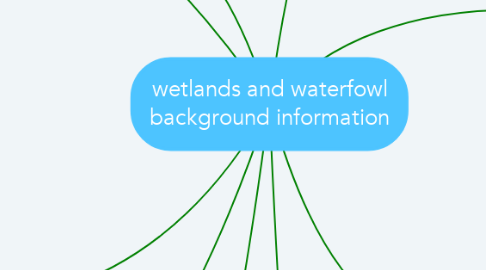wetlands and waterfowl background information
by Kharma Anderson


1. Michigan's Goemaere Anderson Wetland Protection Act, which is now Part 303, Wetlands Protection, of the Natural Resources and Environmental Protection Act, 1994 PA 451, as amended, is a State law that provides for the preservation and proper management of wetlands.
2. History
2.1. about 200 years ago, Europeans arrived, bringing with them the view that the wilderness was an enemy, to be subdued and conquered. Wetlands were considered mysterious and forbidding places, wastelands to be drained or filled at the earliest opportunity.
2.2. twelve thousand years the last ice age was coming to the end of Michigan
2.3. when the glaciers in Michigan melted the moved behind a landscape change.
3. why are wetlands important?
3.1. Wetlands are important because there happen when dry land meets wet surface.
3.2. wetlands play a dig part in are water resources
3.3. more than 40% of 575 vertebrate of the wild life lives off of the wetlands without the wetland most of them would not survive
4. Cycles and Seasonal Needs
4.1. Waterfowl experience an annual cycle that includes several stages, generally dependent on the season. In the winter they bond with a mate, and in the spring, they migrate, breed, nest, and rear their brood. In the summer molting occurs, and in the fall, they migrate again.
4.2. Because of this cycle, waterfowl depend on a mix of wetlands and associated uplands throughout the year as their cover and food needs differ. Cover needs vary as waterfowl breed, nest, and rear broods. Food needs also vary with season. At times, waterfowl may feed extensively on aquatic insects, but at other times their diet may shift to seeds and other plant materials.
5. Wetland Regulations
5.1. Michigan, the Section 404 federal authority associated with interior (inland) waters and wetlands was assumed in 1984 by the Goemaere Anderson Wetland Protection Act. Joint jurisdiction between Michigan Department of Environmental Quality and the U.S. Army Corps of Engineers still exists in commercially navigable waters and wetlands contiguous to those waters.
6. Major wetland types
6.1. Bogs
6.1.1. something that fills in old ponds or swamps or anything like that or in the same category
6.2. marshes
6.2.1. This water type has water to and inch or several feet deep
6.3. swamps
6.3.1. swamps are basically flooded forests or woodland with a lot of moisture

